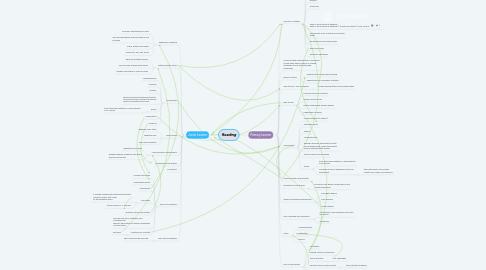
1. Primary Learner
1.1. Science of reading
1.1.1. phonetic sounds
1.1.2. word mapping
1.1.3. syllabus
1.1.4. sound wall
1.1.5. What is the Science of Reading - What is the Science of Reading? | Structured Literacy | IMSE Journal
1.1.6. Assessment looks at timing of decoding words
1.1.7. decoding books vs levels books
1.1.8. Word solve skills
1.1.9. Phonemic awareness
1.2. Communication with parents is important to help them apply science of reading strategies at home to extending knowledge.
1.3. literacy centers
1.3.1. opportunity for play based learning
1.3.2. opportunity for meaningful activities
1.4. learn to read - skill of reading
1.4.1. Understanding letter-sound relationships
1.5. read alouds
1.5.1. common practice in primary
1.5.2. usually picture books
1.5.3. Shared reading and guided reading
1.5.4. independent reading
1.6. Assessment
1.6.1. PM Benchmarks (or others)
1.6.2. decoding words
1.6.3. fluency
1.6.4. comprehension
1.6.5. sharing classroom assessment results across grade levels, within the primary division and within the school;
1.6.6. School based or Board based
1.6.7. EQAO
1.6.7.1. track trends and patterns of improvement in all schools
1.6.7.2. This has become a dependent source or assessment.
1.6.7.2.1. this limits them to an analysis of data from Grade 3 and beyond
1.7. Communication with parents
1.8. teamwork across grades
1.8.1. promote cross-grade collaboration and a collegial approach.
1.9. Stages of Reading Development
1.9.1. Emergent readers
1.9.2. Early Readers
1.9.3. Fluent readers
1.10. Oral Language skills important
1.10.1. As outlined in the Language curriculum document.
1.10.2. vocabulary
1.11. Goals
1.11.1. Comprehension
1.11.2. motivation
1.11.3. fluency
1.12. Role of the teacher
1.12.1. motivation
1.12.2. making cultural connections
1.12.3. plan instruction
1.12.3.1. Set challenges
1.12.4. identify areas of improvement
1.12.4.1. track students progress
1.12.5. plan strategies to meet students needs
1.12.5.1. there is no single instructional program or method that is effective for all children. T
1.12.6. Observing and assessing
1.12.6.1. use a variety of assessment tools
2. Junior Learner
2.1. Reading for meaning
2.1.1. Increase comprehensions skills
2.1.2. links among reading, writing, thinking, and knowing
2.1.3. refine, extend and reflect
2.1.4. connect to self, text, world
2.2. Setting realistic goals
2.2.1. Become strategic readers
2.2.2. Become and independent learner
2.2.3. Deepen motivation to read and learn
2.3. Assessment
2.3.1. comprehension
2.3.2. meaning
2.3.3. analysis
2.3.4. sharing classroom assessment results across grade levels, within the primary division and within the school;
2.3.5. EQAO
2.3.5.1. track trends and patterns of improvement in all schools
2.3.6. Observation
2.3.7. Ongoing
2.4. Read alouds
2.4.1. happens loess often
2.4.2. chapter books
2.4.3. Oral communication
2.5. communication with parents
2.5.1. reading at home daily
2.5.2. Reading requires support of the whole learning community
2.6. teamwork across grades
2.7. Vocabulary
2.8. Role of the Teacher
2.8.1. Provide instruction
2.8.2. scaffolded support
2.8.3. assessment
2.8.4. Motivation
2.8.4.1. s provide reading and writing opportunities based on topics that relate to the student’s world
2.8.4.2. Literacy goal for Jr. learners
2.8.5. making cultural connections
2.8.6. Provide new skills, strategies, and competencies that will equip them to handle increasingly complex texts
2.8.7. Capitalize on curiosity
2.8.7.1. Set goals
2.9. Uses prior knowledge
2.9.1. help communicate meaning
